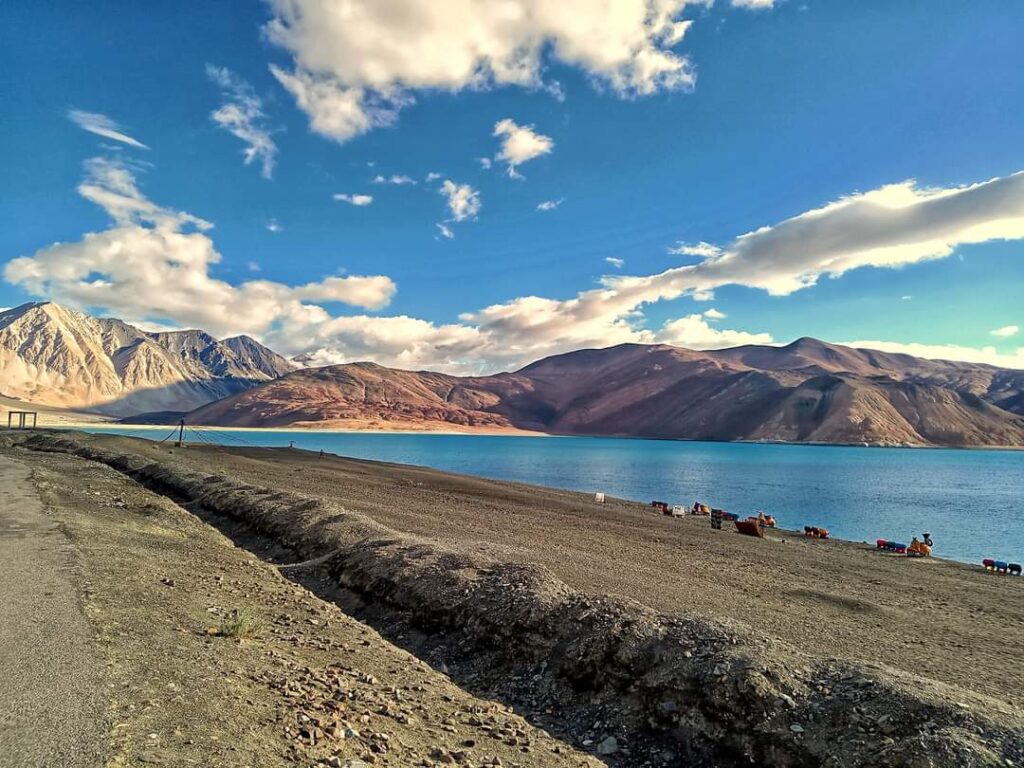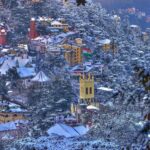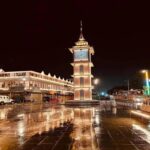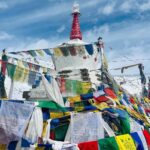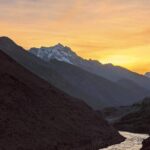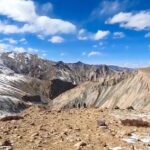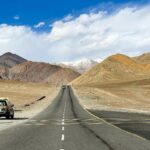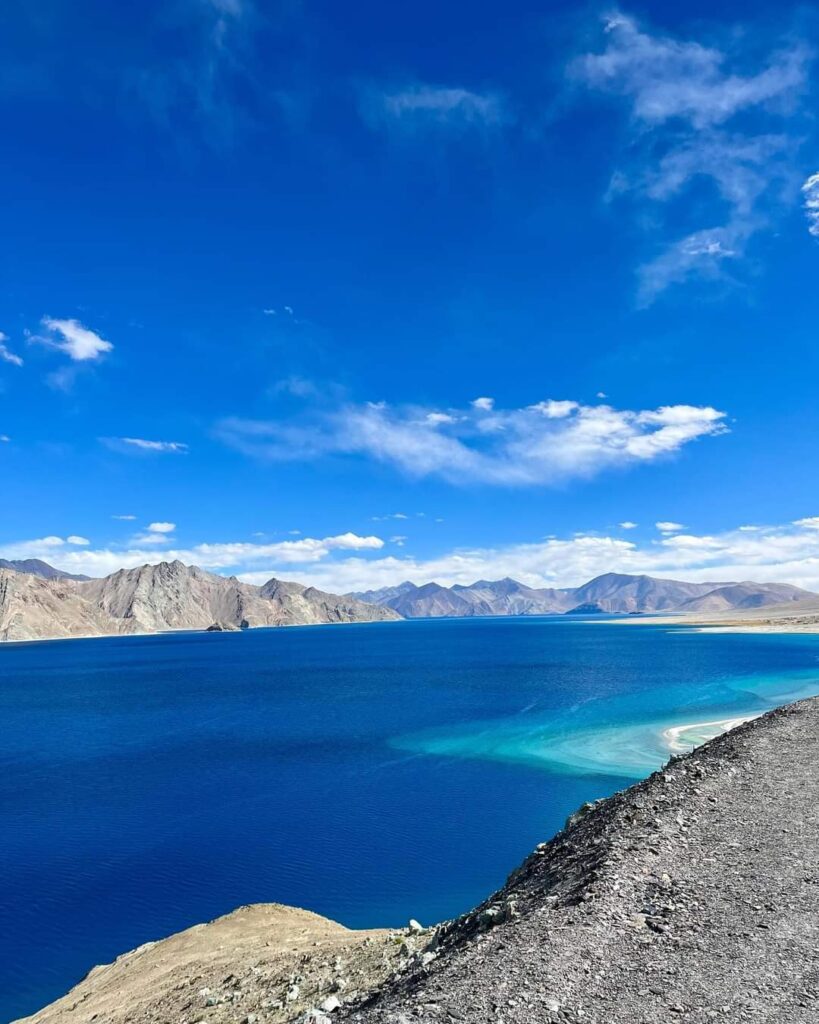
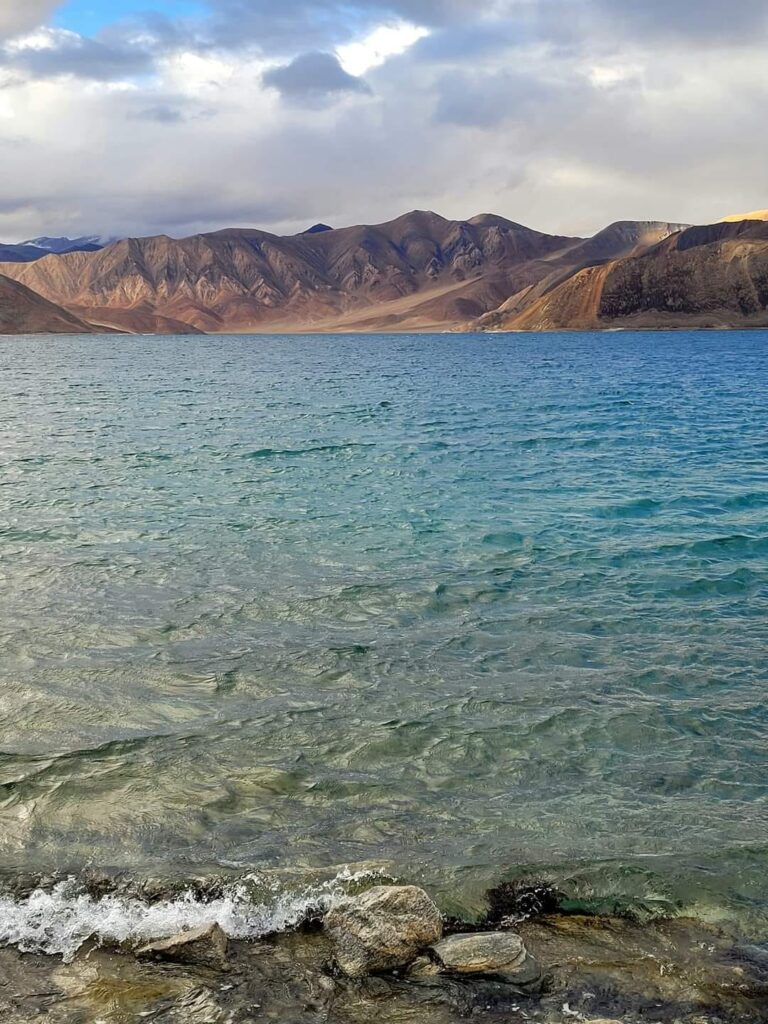
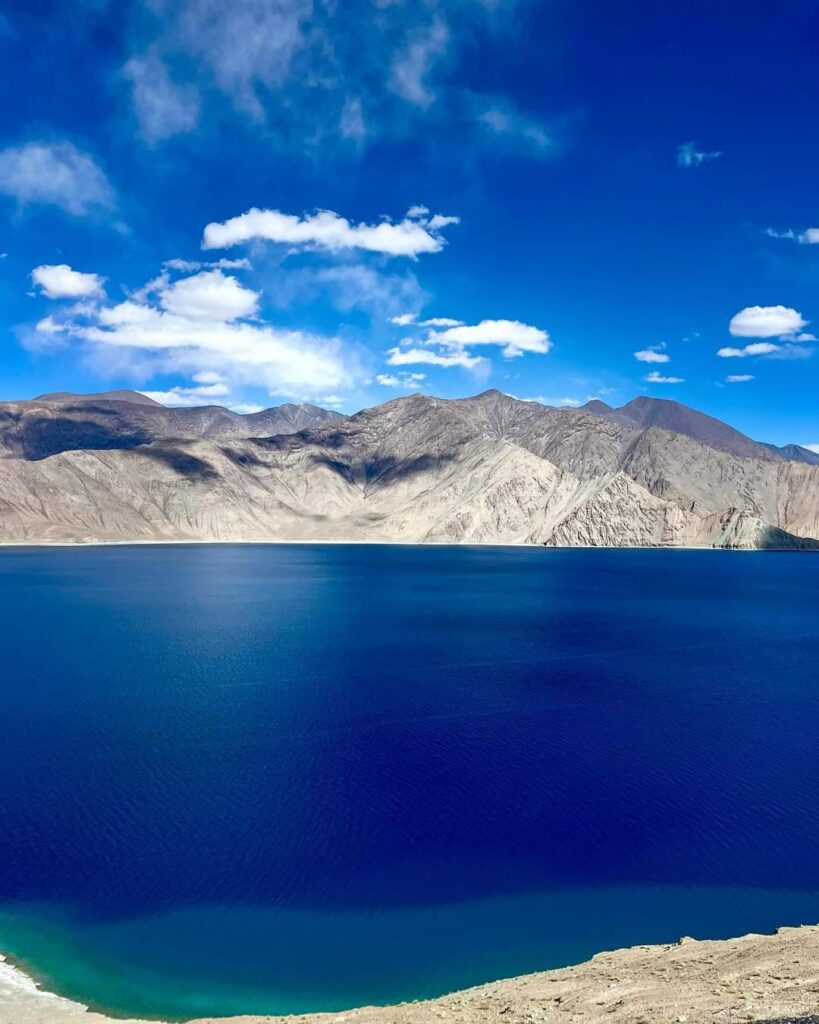
Pangong Tso
Pangong Tso, also known as Pangong Lake, is a high-altitude endorheic lake in the Himalayas. Situated at an elevation of 4,225 m (13,862 ft), it is the world’s highest saltwater lake. The lake is 134 km (83 mi) long and divided into five sublakes, called Pangong Tso, Tso Nyak, Rum Tso (twin lakes) and Nyak Tso. Approximately 50% of the length of the overall lake lies within Tibet in China, 40% in Ladakh, India and the remaining 10% is disputed and is a de facto buffer zone between India and China. The lake’s widest point is 5 km (3.1 mi) across.
Pangong Tso is a popular tourist destination, known for its stunning scenery and its unique turquoise waters. The lake is surrounded by snow-capped mountains and arid plains, creating a breathtaking contrast. The lake’s waters are crystal clear, and its color changes throughout the day, depending on the sunlight and the weather.
Pangong Tso is a great place to relax and enjoy the natural beauty of the Himalayas. Visitors can go for boat rides, swim in the lake, or simply relax on the shore and soak up the scenery. The lake is also a popular destination for birdwatching, as it is home to a variety of migratory birds.
How to reach Pangong tso
There are three main ways to reach Pangong lake: by bus, by taxi, or by flight.
By bus:
The cheapest way to reach Pangong lake is by bus. There are regular buses from Leh to Pangong lake, and the journey takes around 7-8 hours. Buses depart from Leh bus station at 6:30 AM and 7:00 AM every day.
By taxi:
Hiring a taxi is the most convenient way to reach Pangong lake. Taxis can be hired from Leh bus station or from any travel agency in Leh. The journey from Leh to Pangong Tso takes around 5-6 hours.
By flight:
There is no direct flight to Pangong lake. The nearest airport is Kushok Bakula Rimpochee Airport in Leh. From Leh airport, you can hire a taxi to reach Pangong Tso. The journey from Leh airport to Pangong Tso takes around 5-6 hours,
Which mode of transport to choose?
The best mode of transport to reach Pangong Tso depends on your budget and your preferences. If you are on a tight budget, then taking the bus is the best option. However, if you are looking for a more convenient and comfortable option, then hiring a taxi is the best way to go.
History of Pangong Tso
The history of Pangong Tso is long and complex, dating back thousands of years. The lake has been inhabited by various nomadic tribes over the centuries, and has been a site of trade and cultural exchange between India, Tibet, and Central Asia.
In the 17th century, Pangong Tso came under the control of the Ladakhi kingdom. During this period, the lake was an important trade route between Ladakh and Tibet. The Ladakhis also built several forts and monasteries around the lake.
In the 19th century, Pangong Tso became a disputed territory between India and China. The British Indian government claimed the lake as part of Ladakh, while the Chinese claimed it as part of Tibet. The dispute has remained unresolved to this day.
In 1962, Pangong Tso was the site of military action during the Sino-Indian War. The Chinese People’s Liberation Army (PLA) captured the Khurnak Fort area of the lake, and the Line of Actual Control (LAC) was established along the lake.
Today, Pangong Tso remains a sensitive border point between India and China. However, it is also a popular tourist destination, known for its stunning scenery and its unique ecosystem.
why is pangong tso salty
mountains, which are rich in minerals. Over time, the salt has accumulated in the lake, making it salty.
Another reason why Pangong Tso is salty is because of its high altitude. At an elevation of 4,225 meters (13,862 feet), Pangong Tso is one of the highest saltwater lakes in the world. The high altitude causes the water to evaporate more quickly, which leaves behind the salt.
The salinity of Pangong Tso varies depending on the location of the lake. The western part of the lake is more saline than the eastern part. This is because the western part of the lake is shallower and has a higher rate of evaporation.
The salinity of Pangong Tso also varies seasonally. The lake is more saline in the winter than in the summer. This is because the water level in the lake decreases in the winter due to evaporation.
Despite its salinity, Pangong Tso is home to a variety of aquatic life, including fish, crustaceans, and algae. The lake is also a popular destination for migratory birds.
Food and drink in Pangong Tso
Here are some of the most popular food items and drinks in Pangong lake:
Food:
- Thukpa: Thukpa is a Tibetan noodle soup that is made with a variety of vegetables, meat, and noodles.
- Tsampa: Tsampa is a roasted barley flour that is a staple food of Ladakh. It is typically eaten with butter tea or yogurt.
- Momos: Momos are Tibetan dumplings that can be filled with meat, vegetables, or cheese.
- Thali: Thalis are platters that are served with a variety of dishes, including rice, roti, dal, and vegetables.
- Maggi: Maggi is a popular instant noodle brand that is available in a variety of flavors. It is a popular snack or light meal in Pangong lake.
Drinks:
- Butter tea: Butter tea is a Tibetan tea that is made with butter, milk, and salt. It is a popular drink in Pangong lake, as it is high in calories and helps to keep the body warm.
- Coffee: Coffee is available in a variety of cafes in Pangong lake.
- Masala tea: Masala tea is a popular Indian tea that is made with milk, spices, and sugar. It is a popular drink in Pangong lake, as it is refreshing and flavorful.
- Bottled water: Bottled water is recommended in Pangong lake, as the tap water is not safe to drink.
what to do in pangong lake
Pangong Lake, is a stunning high-altitude lake that has gained popularity as a tourist destination, especially after its appearance in the Bollywood movie “3 Idiots.” Here are some things you can do when visiting Pangong Lake:
- Enjoy the Scenic Beauty: The primary attraction of Pangong Lake is its breathtaking natural beauty. The crystal-clear, blue waters of the lake surrounded by towering mountains make it a perfect spot for photographers and nature enthusiasts.
- Camping: Many tourists choose to camp along the shores of Pangong Lake to immerse themselves in its tranquil environment. Camping provides a unique opportunity to stargaze and enjoy the pristine surroundings.
- Photography: The picturesque landscapes around Pangong Lake are a photographer’s dream. The changing colors of the lake, the mountains, and the local wildlife offer countless opportunities for capturing incredible shots.
- Bird Watching: The area around Pangong Lake is home to various bird species, including seagulls, bar-headed geese, and other migratory birds. Birdwatching can be an enjoyable activity for those interested in wildlife.
- Trekking and Hiking: There are several trekking and hiking trails in the region that provide a chance to explore the rugged terrain and enjoy panoramic views. Be prepared for high altitudes and fluctuating weather conditions.
- Cycling: Some adventurous tourists opt for cycling around the lake to explore the area at a slower pace. Make sure to be prepared for the challenging terrain and high-altitude conditions.
- Enjoy Local Cuisine: Savor local Ladakhi and Tibetan dishes at the nearby eateries and guesthouses. Yak meat and momos (dumplings) are some of the popular items to try.
- Star Gazing: The clear night skies at high altitudes make Pangong Lake an excellent spot for stargazing. Bring along a telescope or simply lie on the shore to observe the stars and constellations.
- Meditation and Relaxation: The peaceful and serene environment of Pangong Lake is perfect for those seeking solitude and a break from the hustle and bustle of daily life. Many people come here to meditate and find inner peace.
- Visit Nearby Monasteries: Explore the monasteries in the region, such as Thiksey Monastery and Hemis Monastery, to learn about the local culture and spirituality.
- Learn about the Local Culture: Interact with the local people, the Ladakhis, and experience their unique way of life, including their traditional attire, music, and dance.
Best time to visiting Pangong Tso
Summer (May to September):
- The most popular time to visit Pangong lake is during the summer months, from May to September.
- During this time, the weather is relatively pleasant, and the temperatures can range from 10°C to 20°C during the day.
- The lake thaws, and you can see its mesmerizing blue waters.
- Most of the tourist facilities and accommodations are open during this season.
Early Spring (April):
- If you want to avoid the summer crowds but still see a partially frozen lake, early April can be a good time to visit.
- However, be prepared for colder temperatures, and some parts of the lake may still be frozen.
Late Autumn (October):
- October is another good time to visit, as the weather is still reasonably comfortable, with temperatures ranging from 5°C to 15°C.
- The fall foliage in the surrounding region can be quite picturesque.
Winter (November to March):
- Visiting Pangong lake in winter is possible, but it’s not recommended for casual travelers.
- The temperatures can plummet well below freezing, and the lake is usually frozen solid.
- Access to the area can be restricted due to heavy snowfall and road closures.
Keep in mind that the road to Pangong lake from Leh is often challenging and subject to weather-related closures, so it’s essential to check road conditions and consult with local authorities before planning your trip.
Additionally, the altitude of Pangong lake is over 4,000 meters, so be aware of potential altitude sickness and take precautions such as acclimatization.
Ultimately, the best time to visit Pangong lake depends on your preferences, tolerance for weather conditions, and the type of experience you desire.
Tips for visiting Pangong lake
Plan Your Timing:
- Pangong lake is accessible from April to November, but the best time to visit is during the summer months, from May to September when the weather is relatively pleasant.
- Be aware that the lake may be partially frozen during the early and late months of the season, which can limit access to some areas.
Permits and Documentation:
- Make sure you have all the required licenses and paperwork. Since Pangong lake is located near the border with China, you’ll need an Inner Line Permit (ILP) to visit, which you can obtain in Leh or online.
- Keep multiple copies of your permits and identification for checkpoints along the way.
Accommodation:
- Accommodation options around Pangong lake are limited. It’s a good idea to reserve your lodging in advance, especially during the busiest travel period.
- You’ll find a variety of options, from campsites to guesthouses and luxury tents. Choose based on your tastes and budget.
Altitude Sickness:
- Pangong lake is located at a high altitude (around 4,350 meters or 14,270 feet), and altitude sickness can be a concern. Acclimatize properly in Leh before heading to the lake.
- Stay hydrated, avoid strenuous physical activity upon arrival, and carry medication for altitude sickness if you’re prone to it.
Leave No Trace:
- Respect the natural beauty of Pangong tso by practicing responsible tourism. Pack out all your trash and litter, and do not disturb the local flora and fauna.
- Follow the “Leave No Trace” principles to minimize your impact on the environment and preserve the pristine nature of the region.
Bonus Tip:
- Be prepared for limited mobile network coverage, so inform your loved ones about your travel plans in advance.
- Carry warm clothing as the nights can be extremely cold, even during the summer months.
- Remember that the journey to Pangong tso can be long and challenging, so be patient and enjoy the breathtaking landscapes along the way.
Pangong is a magical destination that offers a unique and awe-inspiring experience. Following these tips will help ensure a safe and enjoyable visit to this beautiful Himalayan gem.
Conclusion
Pangong tso, a stunning high-altitude lake in Ladakh, India, is a place of remarkable natural beauty and tranquility. Here is a brief conclusion about Pangong :
- Natural Beauty: Pangong is renowned for its breathtaking natural beauty. The lake’s unique shade of blue, surrounded by arid mountains, creates a surreal and picturesque landscape.For photographers and wildlife enthusiasts, it is a paradise.
- High Altitude: Situated at over 4,000 meters above sea level, Pangong offers a unique high-altitude experience. Visitors need to be prepared for the challenges of high-altitude travel, including potential altitude sickness.
- Seasonal Variation: The lake’s appearance changes with the seasons. It’s a different experience whether you visit in summer, early spring, late autumn, or winter. Each season has its own charm.
- Road Access: Access to Pangong from Leh can be challenging, as the road is subject to weather-related closures, especially during winter. Road conditions should be checked before setting out on a trip.
- Tourist Facilities: The region around Pangong has seen an increase in tourism, so there are now accommodations and facilities available, making it easier for visitors to explore the area.
- Cultural Experience: The journey to Pangong often involves passing through traditional Ladakhi villages, which offers a chance to experience the local culture and interact with the residents.
- Remote and Peaceful: Despite the growing popularity, it still maintains an air of remoteness and tranquility, which can be a draw for those seeking a break from the bustling city life.
- Ladakh Exploration: A visit to Pangong can be part of a larger exploration of the Ladakh region, with its unique culture, monasteries, and high-altitude desert landscapes.
In conclusion, Pangong tso is a must-visit destination for nature enthusiasts, adventure seekers, and those who appreciate serene landscapes. The lake’s changing beauty throughout the seasons and the unique experience of being at such a high altitude make it a memorable destination for travelers. However, proper planning and awareness of the challenges, including altitude and seasonal access, are essential for a safe and enjoyable visit.
Discover the Magic of Kashmir’s Natural Beauty in Our New Blog – An Adventure You Can’t Miss! THIKSEY MONASTERY , LEH ~ LADAKH , SHANTI STUPA , LEH PALACE
